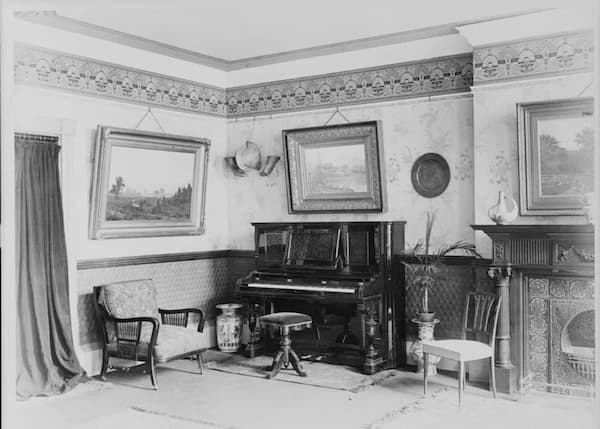
© Science Focus
When our contributors were asked to list the work that they thought best for meditation or reflection, they ranged around the entire musical spectrum from J.S. Bach to Steve Reich. Come ponder on the wonders of classical music with these pieces.
 | Anson Yeung: medical student |
Grieg’s Piano Concerto in A minor is well known for its majestic first movement and bouncing third movement, but the second movement is nothing short of extraordinary. Beginning with a heart-warming theme, the exquisitely meditative Adagio evokes memories of sitting on a plain field watching a starry sky (at least for me!). Conveying remembrance without excessive sentimentality or affectation, this piece has the ability to free us from our everyday troubles. May I invite you to spend a quiet night and listen to it with your eyes closed…
Edvard Grieg: Piano Concerto in A Minor, Op. 16: II. Adagio (Dinu Lipatti, piano; Philharmonia Orchestra; Alceo Galliera, cond.)
Chris Lloyd: Berlin-based concert pianist, curator, author, co-founder of the international interdisciplinary movement, Crossmodalism, and founder of the 1781 Collective. |
The night I discovered this Steve Reich ballet piece from 1966, Come Out, I was in a work meeting with a performer, and we were trying to develop something that was getting nowhere – both of us too tired to really switch our brains on. Then I remembered I had read about the piece, and that we could listen to it; on a huge sound system with the lights turned off, lying flat on the ground with perfume-scented hand towels covering our faces, because, why not? That led to the development of the ‘Crossmodalist Triptych Meditation Series’ which one friend likened to a 3-hour deep-state meditation in 13 minutes, and another equated with being on DMT. Fun times all around!
Steve Reich: Come Out
Doug Thomas: pianist, composer, writer, and founder of the NOOX recording label. |
Pärt’s Spiegel Im Spiegel (Mirror(s) in the Mirror) is a piece that makes me stop, that prompts me to listen and devote myself to the music. It allows the moment to exist and be mindful. This piece has also been intentionally left open for rearrangements, which makes it incredibly rich in sensations. It is universal and free. The piece is set on Pärt signature tintinnabular style, based on bell-like melodic structures. It is also a great example of balance between the mind — and the interplay of the voices in order to achieve the mirror in mirrors effect — beauty, and the soul.
Arvo Pärt: Spiegel im Spiegel (Angele Dubeau, violin; Marie-Ève Scarfone, piano)
Ellen Wong Tso: pianist, writer, and one of the busiest teachers, examiners, and adjudicators in Canada for decades. |
In retrospect, I was blessed to have had classical music enrich my journey through life’s maturation process. First there was the cerebral stage with Bach’s Well-Tempered Clavier where all voices in the counterpoint were diligently solfèged, and all harmonic progressions were meticulously analyzed. Following that was the visceral stage with Mahler‘s symphonies, where I wallowed for long hours in inexplicable self-pity. Then as I progressed into a philosophical stage, I was enticed by Beethoven‘s passionate encounters with humankind’s sufferings, empathizing with his many trials and tribulations. Now that I am approaching the twilight years, I must admit that simplicity is at the forefront of all priorities. The perfect piece of music that could espouse peace and harmony, especially in these stressful times, would have to be Schumann’s Scenes from Childhood, Op. 15, with a special tribute to #7 – “Traumerei”. Sentiments portrayed are raw and rich, harmonic modulations fresh and arousing, and despite the dearth of complex thematic development, depiction of these innocent images aptly reflects humanity’s warmth and joy.
Schumann: Kinderszenen Op.15, “Scenes from Childhood”
Emily E. Hogstad: music blogger and social media activist in the orchestra world. |
The closest thing we violinists have to a Bible is Bach’s six sonatas and partitas for solo violin. What movement I’d consider to be the “best” changes from day to day and year to year. But the one I’ll always love best is the third movement Andante from the second solo sonata in A minor. My favourite performances invariably clock in around 60 beats per minute, presumably because that tempo mimics both a slow resting heart beat and the ticking hand on a watch. For roughly six minutes, Bach asks the violinist to voice peacefully intertwining lines, accompanying themselves in a sparse, elegant fashion by playing on multiple strings at once. As long as the performer is accomplished enough to not hint at how difficult that is to pull off, the piece achieves a placid, powerful honesty that no other instrumentation or composer could ever dream of duplicating.
J.S. Bach: Sonata for Violin Solo No. 2 in A Minor, BWV 1003 – III. Andante
Frances Wilson: pianist, piano teacher, music reviewer and blogger. |
Balta ainava (White Scenery) by Pēteris Vasks is wonderfully meditative to listen to and also to play. The music portrays the stillness and silence of a snowy landscape using simple repeated quaver motifs interrupted by long rests and gentle chords. Scored in the upper registers of the piano, the music has a delicate gracefulness, offering moments to pause and reflect.
Pēteris Vasks: Die Gadalaiki (The Seasons): No. 1. Balta ainava (White Scenery) (Georgijs Osokins, piano)
Georg Predota: pianist, musicologist, and writer |
When it comes to meditation and/or reflection I really don’t have a single perfect musical track. Rather, I have a perfect composer in Johann Sebastian Bach. And I don’t mean that in a sentimental or nostalgic sense. Scholars have rightfully suggested, “Bach’s music naturally provides a psychological refuge for all of humanity.” It contains wondrously distilled beauty, a vision of otherworldliness and a universe of comfort and reflection. I always try to remember, however, that Bach’s music does not miraculously come from the gods but from a deep sense of connectedness to the human experiences and heart-felt emotions. No matter if his music is adopted for brass quintet, the ukulele, the didgeridoo, or the banjo, his music according to Fischer-Dieskau, “is the language of the soul.” The key to Bach’s music is a decidedly spiritual dimension, and that connection can truly be shared across all nations and all cultures.
J.S. Bach: Wie schön leuchtet, BWV 1
Guy Francis: intellectual melomania and refined listener. |
There’s much to reflect upon in Bach’s The Art of the Fugue. Though consensus is reached around it being a keyboard work, probably for organ, musicians have a field day highlighting its subtle beauties on every variety of instruments: strings, winds, accordions, etc.; a perfect exercise in the complexities of orchestration and organ/harpsichord registration. The heart-stopping meditation, however, comes at the end, as Bach builds up a concentrated emotional climax, unprecedented in his whole output…. left unfinished. He took his secrets to the grave, and the greatest musical minds have failed to retrieve them.
J.S. Bach: The Art of Fugue, BWV 1080
Hermione Lai: student and music enthusiast. |
For many people around the world, these are stressful times indeed. Lots of my friends are taking Tai chi or yoga classes for health benefits and for meditation. I have found that classical music is great for meditation and reflection, and my favourite composer is Claude Debussy. I just love all his music, no matter if arranged or not, because it doesn’t attempt to preach. It never is in your face, but simply evokes a feeling or conveys a mood. It is not deeply emotional but it lets me discover the suggestions between the notes. And that for me is the perfect space for mediation and reflection.
Debussy: The Girl with the Flaxen Hair (Cello Quintet)
Janet Horvath: professional cellist, writer, and award-winning advocate for injury prevention. |
The English horn or cor Anglais is the ravishing voice of the swan, which guards Tuonela in this second of four tone poems by Jean Sibelius from the Lemminkainen Suite Op. 22. Surrounded by dark fast-moving waters, the swan glides over muted strings. From the depths of the river, spiraling heavenward, the lone voice of a solo cello rises in counterpoint from afar. The swan sings on the periphery of the Finnish equivalent of Hades, the music haunting, and for me, meditative, as if we contemplate what might follow after life on earth. Whatever your interpretation this is an exquisite piece.
Jean Sibelius Lemminkainen Suite, Op. 22: The Swan of Tuonela (London Philharmonic Orchestra; Paavo Berglund, cond.)
Maureen Buja: musicologist and writer. |
For a piece that makes you think and makes you look at the world from another perspective, I look to George Crumb. His work for extended vocal technique, Ancient Voices of Children, casts you into a hot Spanish village. A little boy is looking for his voice, and singer Jan DeGaetani’s vocalizations take you out of the world. The work as a whole is striking and sad and perfect for when you just want to enter someone else’s sound world.
George Crumb: Ancient Voices of Children: I. El nino busca su voz (The Little Boy was looking for His Voice) (Jan DeGaetani, mezzo-soprano; Michael Dash, boy soprano; Contemporary Chamber Ensemble; Arthur Weisberg, cond.)
Nicolette Wong: professional pianist, writer, and music educator. |
I like listening to music by J.S. Bach in the mornings because his compositions offer me some ‘me time’ to reflect and prepare myself for the day ahead. His music is orderly and regular: it allows me to organise my thoughts and mentally get ready for the tasks I have to complete. I also find his intellectual writing very inspiring and motivating. In particularly, I love listening to his Cello Suites first thing in the morning.
J.S. Bach: Cello Suite No.1 BWV 1007
Oliver Pashley: clarinettist and member of The Hermes Experiment |
Steve Reich’s Music for 18 Musicians is a cornerstone of the minimalist repertoire and takes me to a place not much other music takes me to. There’s something about listening to his music that makes me feel like I’m in a dark room watching an infinitely shifting world of colours slowly transforming in front of my eyes. I’ve always admired the way Steve Reich’s music knits itself together and pulls you into its sound world, and after I finish listening to this piece in particular I emerge like from a meditation, with fresh eyes and a sense of calm perspective.
Steve Reich: Music for 18 Musicians (Steve Reich and Musicians)
Philip Eisenbeiss: headhunter in banking and finance, writer and lecturer about Opera. |
It is often said that Mozart’s or Bach’s music makes you think. I cannot claim to share that impression. It is bel canto grandmaster Gioachino Rossini’s music that has that effect on me. Its clever structure, enchanting melodies, and unexpected addictiveness never fail to draw me into a meditative mood. Witness the simple willow aria from his Otello, with its melodic line beginning merely with a harp before drawing in the mezzo-soprano. Academics have written tomes about the musical structure, the mimetic tropes of the text, the eery sadness and loneliness the composer conjures up. I just reflect on the mastery of this work and how it was possible for Rossini’s opera seria to be dethroned by Giuseppe Verdi’s eponymous masterpiece over 70 years later.
Gioachino Rossini: Otello – “Assisa a pie d’un salice”
Rob J. Kennedy: composer and arts journalist. |
I think much of J.S. Bach’s music could be used for meditation. The Adagio from Bach’s Violin Concerto in E Major BWV 1042 makes me sit back and ponder. Usually, I think about just how damn amazing Bach is. But this puts a person into a state of reflection and relaxation. This piece has been sending people into a meditative state for about 260 years. I kind of figure that in another few hundred years, people will still be studying Bach as we do today, and his music will keep transfixing us and sending our thoughts to sublime places in pleasant reveries.
J.S. Bach: Violin concerto in E major BWV 1042 – II. Adagio
After all the excitement of love or the energy of the world, sometimes we just need to sit and think. Or sit and not think. These selections of music for reflection and meditation may be just the thing you need after a long day or to give you a pause in mid-day. Whenever you want to take some time out for yourself, bring along a classical composer or two.
For more of the best in classical music, sign up to our E-Newsletter










